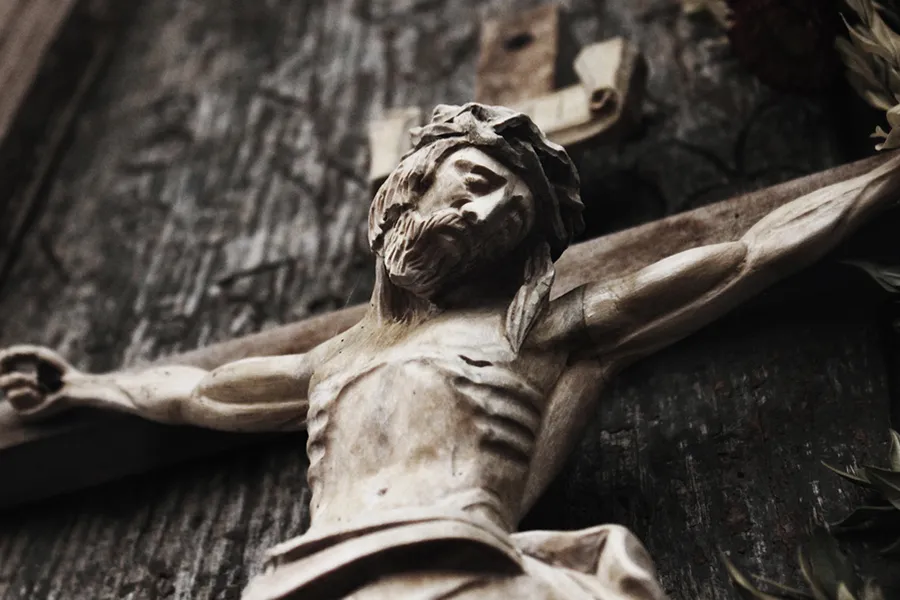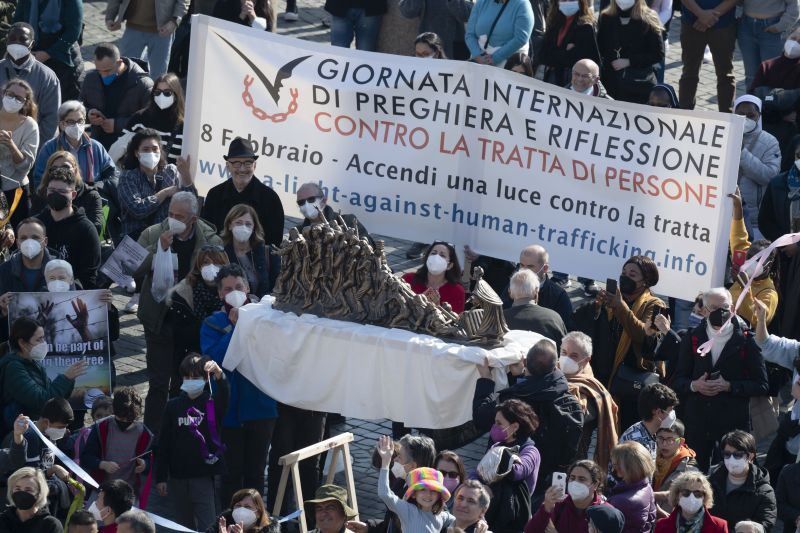
Vatican City, Apr 11, 2017 / 03:33 pm (CNA/EWTN News).- Pope Francis chose French biblical scholar, Anne-Marie Pelletier, to write the meditations for this year's annual Good Friday Stations of the Cross at the Colosseum.
A recipient of the Ratzinger Prize in 2014, as well as a wife and mother, Pelletier’s meditations follow her own scripturally-based Stations of the Cross, or Via Crucis, based on the 14 biblical stations used by St. John Paul II in 1991.
Because the Stations of the Cross do not have a “binding form,” Pelletier told Vatican Radio, “I chose those moments that seemed particularly significant.”
Her stations are not significantly different from the traditional 14 stations followed by pilgrims walking the Via Dolorosa in Jerusalem, though the biblical stations don’t include the three falls of Jesus or Veronica wiping the face of Jesus as in the traditional devotion.
She also begins with Jesus’ condemnation, rather than his prayer in the garden of Gethsemane.
Using more than just the accounts of Christ’s Passion in the Gospels, Pelletier’s reflection weaves in Scripture and biblical references from both the Old and New Testaments as she reflects on how the entire life of Christ has been leading him, and us, to his ultimate sacrifice.
Pelletier’s meditations also reflect significantly on the perspective of the women along Jesus’ path, especially his mother, Mary.
An important scholar of contemporary French Catholicism, Pelletier has taught biblical studies at the European Institute of Religious Sciences and served as vice-president of the Jewish-Christian Documentation Information Service in Paris. She is the first woman to win the Ratzinger Prize.
The Ratzinger Prize was begun in 2011 to recognize scholars whose work demonstrates a meaningful contribution to theology in the spirit of Cardinal Joseph Ratzinger, the Bavarian theologian who became Benedict XVI.
The prize is awarded by the Ratzinger Foundation, which was founded in 2010 with Benedict XVI’s approval to study and promote his writings as a theologian, as a cardinal in charge of the Vatican’s Congregation of the Doctrine of the Faith, and as Pope.
Pelletier opens the stations with Jesus’ condemnation before the members of the Sanhedrin, who “did not need a lengthy discussion to come to a decision,” she wrote. “The matter had long been settled. Jesus must die!”
Showing how at each point of his life Jesus faced enemies, she wrote that “our recollection must go back even further,” to Bethlehem, to Jesus’ very birth, when “Herod had decreed that he must die.”
Jesus escaped that time, but “already his life hung in the balance. In the sobbing of Rachel mourning her children who are no more, we hear a prophecy of the sorrow that Simeon will foretell to Mary (cf. Mt 2:16-18; Lk 2:34-35),” she writes.
In the fourth station, when Jesus is crowned with a crown of thorns, draped in a purple cloth and mocked with the words, “Hail, King of the Jews!” the paradox of Jesus’ kingship is revealed to us “as a love that seeks only the will of his Father and his desire that all should be saved.”
In this station she prays, “Lord our God, on this holy day that brings your revelation to fulfillment, we ask you to tear down every idol in us and in our world. You know the sway they have over our minds and our hearts. Tear down in us every deceitful illusion of success and of glory.”
When Jesus meets the mourning women of the daughters of Jerusalem, at the seventh station, Pelletier reflects on the gift of tears Jesus bestows upon them, asking them not to weep for him, but for the world.
The tears “fall silently down their cheeks. And undoubtedly, even more often, they fall unseen in the heart, like the tears of blood spoken of by Catherine of Siena,” she writes. “Not that women alone should weep…” she emphasizes, though it is their grief that “embraces all those tears shed quietly and without fanfare in a world where there is much to weep for.”
The eleventh station is devoted to Jesus and his mother Mary. Throughout her son’s life, Pelletier writes, Mary had entrusted each event “to the great patience of her faith” and today, the day of his crucifixion “is the day of fulfilment.”
“The sword that pierced her Son’s side pierces her own heart. Mary too plunges into that bottomless trust whereby Jesus lives to the full his obedience to the Father. Standing there, she does not desert him. Stabat Mater. In the darkness, but with certainty, she knows that God keeps his promises.”
The reflection on the tender faithfulness of women continues in the final station, as Jesus is laid in the tomb and the women prepare to anoint his body the following morning at daybreak, after the Sabbath has ended.
“Grant too that we, who have accompanied you along this path of love to the very end, together with the women of the Gospel, may remain in expectant prayer,” Pelletier concludes.
“For we know that our prayers will be answered by the resurrection of Jesus, which your Church now prepares to celebrate in the joy of Easter night.”
If you value the news and views Catholic World Report provides, please consider donating to support our efforts. Your contribution will help us continue to make CWR available to all readers worldwide for free, without a subscription. Thank you for your generosity!
Click here for more information on donating to CWR. Click here to sign up for our newsletter.




THE WAY OF THE CROSS
Complete and biblically-documented
+ + + + + + + + + + + + + + +
(1) FIRST STATION – Jesus is betrayed by Judas and arrested in the Garden of Gethsemane.
(2) SECOND STATION – Jesus is abandoned by Peter and the Apostles.
(3) THIRD STATION – Jesus is condemned to death by the Sanhedrin and Pilate.
(4) FOURTH STATION – Jesus is scourged.
(5) FIFTH STATION – Jesus takes up His Cross.
(6) SIXTH STATION – Jesus is helped by Simon of Cyrene.
(7) SEVENTH STATION – Jesus meets the women of Jerusalem.
(8) EIGHTH STATION – Jesus is nailed to the Cross.
(9) NINTH STATION – Jesus is mocked on the Cross.
(10) TENTH STATION – Jesus promises the Paradise to the Good Thief.
(11) ELEVENTH STATION – Jesus speaks from the the cross to His Mother and the Apostle John.
(12) TWELFTH STATION – Jesus dies on the Cross.
(13) THIRTEENTH STATION – Jesus’ side is pierced with a lance.
(14) FOURTEENTH STATION – Jesus is buried.
(15) FIFTEENTH STATION – Jesus descends to the dead and liberates the Faithful.
“In the tomb with the body and in hell with the soul, as God, in paradise with the thief, and on the throne with the Father and the Spirit, wast Thou, o boundless Christ, filling all things!”
[Ephesians 4:9, 1 Peter 3:19; the Byzantine Liturgy].
_________________________________________
The original Italian edition Via crucis – Completo e biblicamente documentato is based on the 15 stations of the Way of the Cross in Marija Bistrica, Croatia, on the Via Crucis – Venerdì Santo 1991, 1994, 1995, of Pope John Paul II, VATICAN.VA, and on the Byzantine Liturgy, SLAVXRIST.ORG; blessed by Bishop Virgilio Pante, I.M.C., Maralal, Kenya; published by Consolata Missionaries 6.12.2006. English edition: Consolata Missionaries, 2671 Islington Ave., Toronto, ON M9V 2X6 Canada CONSOLATA.CA 6.1.2007.